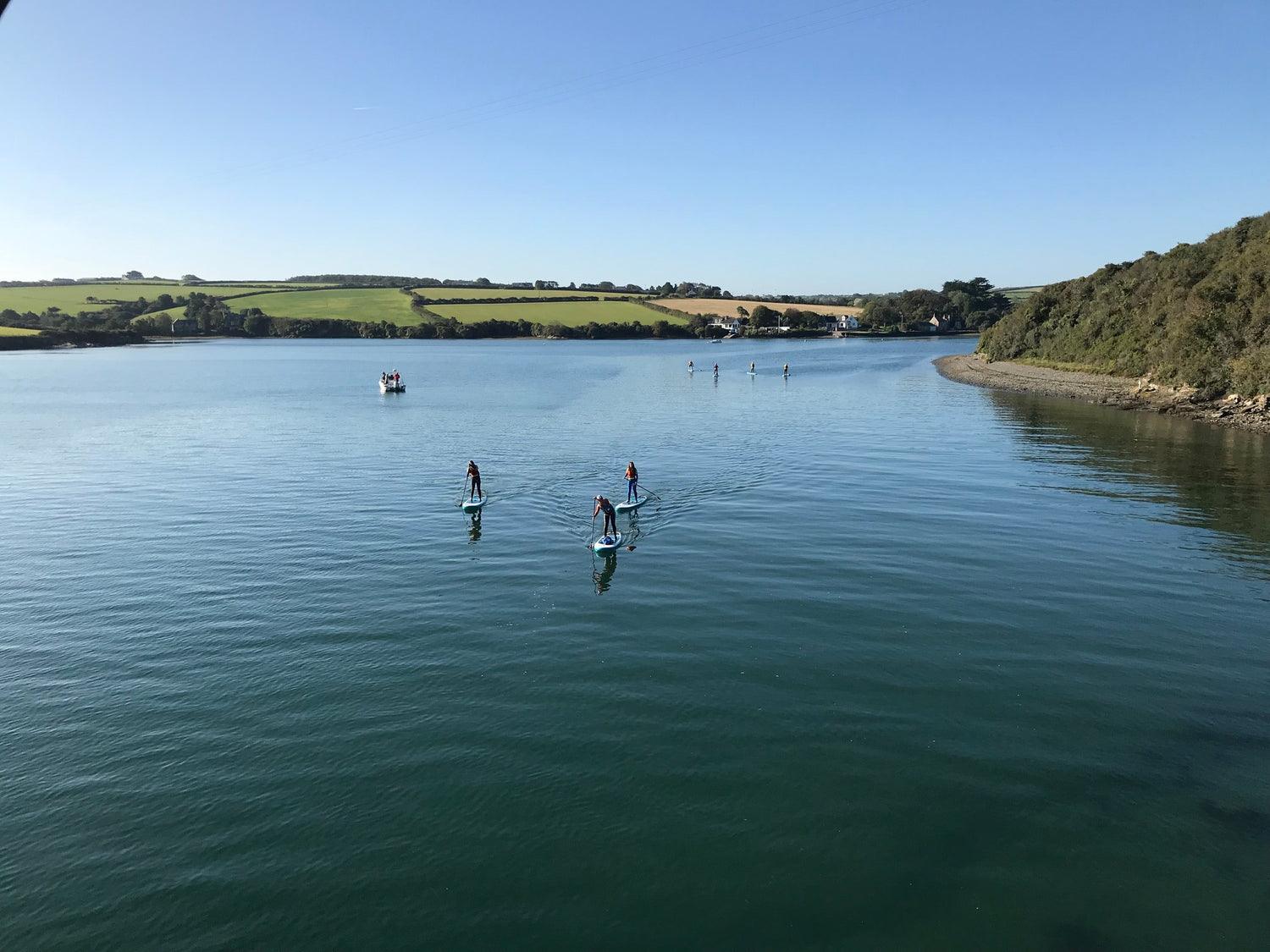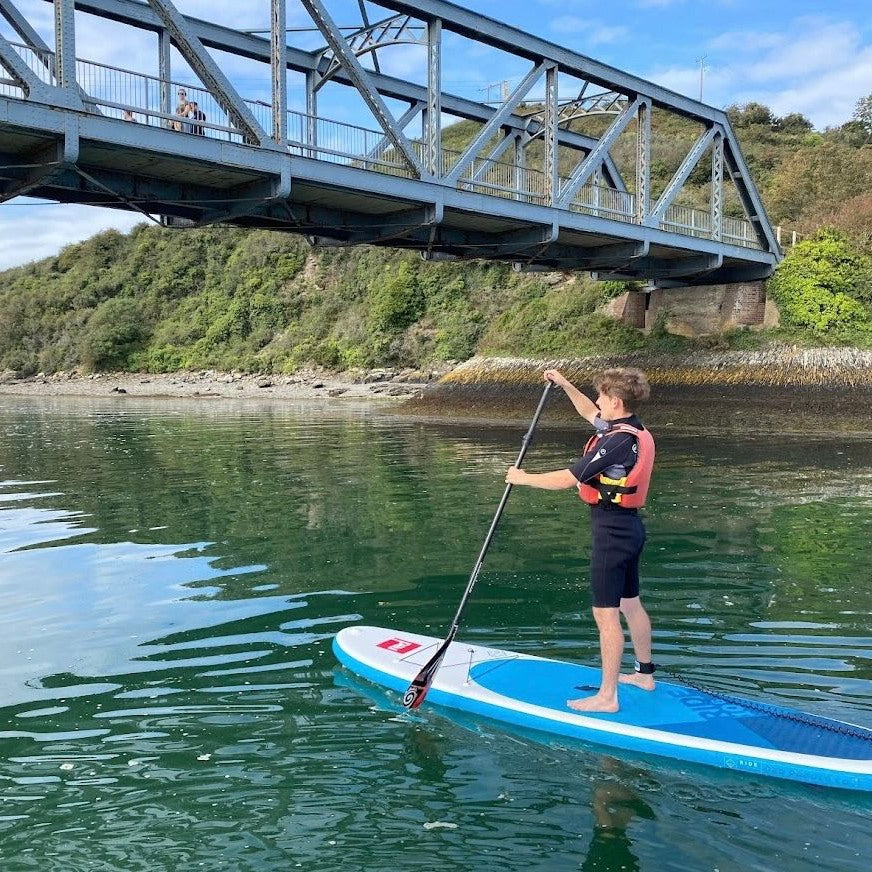
Paddleboarding from Padstow on the beautiful Camel Estuary.
Where can I paddle safely from Padstow, Cornwall?
Paddleboarding in the Camel Estuary area is superb when the conditions are right, there’s so much to see and experience. It is important to know your limits and ability level and to not paddle in winds greater than force 3 unless you are experienced. Check the weather and wind forecast before you go paddling as conditions can change rapidly. The Camel estuary is a busy waterway, and you must abide by maritime rules, not to mention a fast-flowing tide. I would recommend that you avoid paddling anywhere at the mouth of the estuary and the best place to enjoy a safe paddle is south of the port at Porthilly view, away from boat traffic and fast flowing tides. Check out the Padstow Harbour Commissioners website for essential safety advice.
Safety is key, and below I have listed a considerate route to paddle, I hope you enjoy! 😊
Where is the best place to launch?
There are a choice of launching points but one of the best is at Porthilly view about 1km south of Padstow at the start of the Camel Trail. Here you have fantastic views of the river Camel, up to Padstow, across to Rock and sweeping up the estuary towards Wadebridge and over to The Iron Bridge, the old Railway Bridge which is on the famous Camel Trail. A lot of locals park here, and it does get busy in season, so beware. The launch point is a short walk across the Camel Trail to a small slate and pebble beach. If you are lucky to be staying or visiting friends at The Dennis Cove Campsite, they also have a slipway with access directly onto the estuary. Parking in the area in the height of the season is very limited so you may be best to drop your kit off and use the local car parks and/or the park and ride facility.

The best times to paddle are about 1.5hrs before high tide and using the flood tide (tide coming in), you can paddle towards the Iron Railway Bridge keeping close to the shore below the campsite. If you paddle in this direction, you will avoid most boating traffic. Please bear in mind tides here move reasonably fast especially on Spring tides and boat moorings should be avoided. There is also a water ski area which must be avoided and give shore fishermen a wide berth. Check out the map on the harbour commissioner’s website to see the restricted areas. As you reach the Iron Bridge and paddle underneath you would have reached the tidal turn and have about an hour of slack water to enjoy before the ebb tide starts to go out again. Here you have a great expanse of water to play in without much boat traffic. You can enjoy the serenity, the glorious views and lots of birdlife such as Egrets, Gannets, Gulls, Terns and Curlew. Paddle further upstream and see Grey Herons, little Egrets, and Kingfishers, which feed along its banks. On a spring tide, and if conditions allow, you can paddle right up to the pretty hamlet of Little Petherick. Maybe even have time for a drink or a cream tea at the Old Mill House. The distance from Dennis Cove to Little Petherick is about 3 km, and it will take you about 90 mins to paddle there and back, depending on the tide and the wind direction.
Safety Tips for Paddling in the Camel Estuary.
Stand Up Paddleboarding is becoming one of the fastest growing activities in the country with equipment readily available from supermarket shelves, easily obtainable for the most inexperienced of users. We
hope you take time to read the safety information below to make your experience as safe and as enjoyable as possible.
STAY AFLOAT:
Wear a Personal Floatation Device when on the water or have an additional means of floatation.
STAY IN TOUCH:
Tell someone ashore where you are going and when you will be back. Carry a mobile phone in a waterproof case to use as a means of calling for help. Keep the phone on your person and not tucked away in the bottom of a dry bag.
STAY CONNECTED:
A leash is an essential part of your paddle boarding gear. To navigate moorings, it’s better to have a quick
release waist leash for this environment. If you fall in and cannot remount your board stay/float with your equipment, you will be easier to find.
PLAN YOUR ACTIVITY:
Check the weather and tides before you go out and contact the harbour office/launch facility for any relevant safety information.
KNOW YOUR LIMITS:
Offshore winds are dangerous and may blow you away from shore. Wind against tide will create waves in calm conditions. Paddle into the elements first to make the trip home easier.
STAY CLEAR:
The river Camel is a busy navigable estuary. Keep clear of the navigable channels and only cross the channel when it is safe to do so and at the narrowest point. When passing through the zoned ski area, stay to the edges and pass through as quickly as possible. Do not paddle to the busy harbour area. This is a commercial port with a lot of boat traffic, avoid paddling to the mouth of the estuary as there are strong tidal currents and lots of boat traffic.
INCIDENT:
If you get into difficulty, stay with your equipment, and call for help. Ask for the coastguard on 999 or VHF
Channel 16. All incidents must be reported to the Padstow Harbour Office.

Harlyn Surf School
So please paddle with a waist quick release belt leash and buoyancy aid for your safety. Never paddle alone. If you are inexperienced join a group with an experienced and qualified licenced SUP Paddle Company. I would recommend Harlyn Surf School: This is one of the first companies in the UK to teach SUP, having started in 2006. They offer SUP lessons and tours on the estuary for all levels of experience. You can learn the basics of paddleboarding, explore the stunning coastline, or join a SUP safari to see wildlife such as seals and dolphins. They provide quality wetsuits and boards and have a team of highly trained and passionate instructors.
The trips are great fun however safety is paramount, which is discussed in and out of the water.
